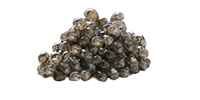Thank you for visiting the Seafood Selector. EDF is planning a new approach to providing information to consumers about good seafood choices. Please come back soon for updates.
Caviar

Caviar
Recommended servings per month
| Contaminant | Men | Women | Kids 6-12 | Kids 0-5 | |
|---|---|---|---|---|---|
| Paddlefish (farmed) | Unknown | 4 | 4 | 4 | 4 |
| White sturgeon (farmed) | Unknown | 4 | 4 | 4 | 4 |
| Osetra (wild, imported) | Unknown | 4 | 4 | 4 | 4 |
| Lake sturgeon (wild, imported) | Unknown | 4 | 4 | 4 | 4 |
| Beluga sturgeon (wild, imported) | Unknown | 4 | 4 | 4 | 4 |
| Sevruga (wild, imported) | Unknown | 4 | 4 | 4 | 4 |
| White sturgeon (wild, OR and WA) | Unknown | 4 | 4 | 4 | 4 |
| Paddlefish (wild) | Unknown | 4 | 4 | 4 | 4 |
| Russian, Siberian, White, Beluga, Sevruga (U.S., farmed) | Unknown | 4 | 4 | 4 | 4 |
Eco details:
- Enormous international demand for caviar has significantly depleted most wild sturgeon and paddlefish populations worldwide.
- Caviar from the Caspian region (Beluga, Osetra, Sevruga) is particularly prized, and illegal poaching and habitat degradation have driven many of these sturgeon species to the brink of extinction.
- Caviar from farmed white sturgeon and paddlefish is an eco-friendly and less expensive alternative.
- Small numbers of white sturgeon are fished in Washington and Oregon, where management helps to curb overfishing of this long-lived species.




